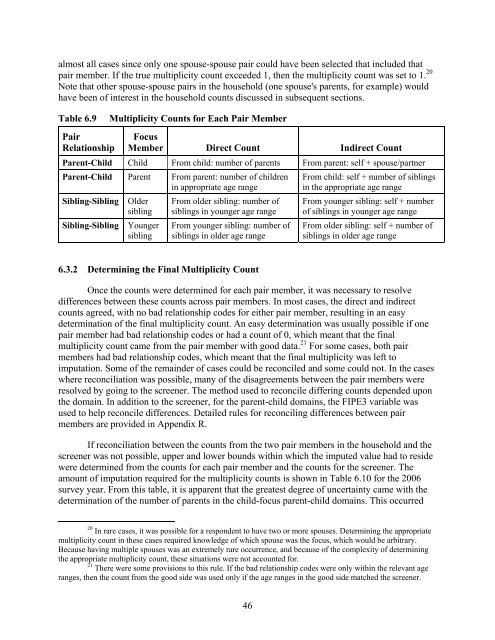Questionnaire Dwelling Unit-Level and Person Pair-Level Sampling ...
Questionnaire Dwelling Unit-Level and Person Pair-Level Sampling ...
Questionnaire Dwelling Unit-Level and Person Pair-Level Sampling ...
Create successful ePaper yourself
Turn your PDF publications into a flip-book with our unique Google optimized e-Paper software.
almost all cases since only one spouse-spouse pair could have been selected that included that<br />
pair member. If the true multiplicity count exceeded 1, then the multiplicity count was set to 1. 20<br />
Note that other spouse-spouse pairs in the household (one spouse's parents, for example) would<br />
have been of interest in the household counts discussed in subsequent sections.<br />
Table 6.9<br />
<strong>Pair</strong><br />
Relationship<br />
Multiplicity Counts for Each <strong>Pair</strong> Member<br />
Focus<br />
Member Direct Count Indirect Count<br />
Parent-Child Child From child: number of parents From parent: self + spouse/partner<br />
Parent-Child Parent From parent: number of children<br />
in appropriate age range<br />
Sibling-Sibling<br />
Sibling-Sibling<br />
Older<br />
sibling<br />
Younger<br />
sibling<br />
From older sibling: number of<br />
siblings in younger age range<br />
From younger sibling: number of<br />
siblings in older age range<br />
From child: self + number of siblings<br />
in the appropriate age range<br />
From younger sibling: self + number<br />
of siblings in younger age range<br />
From older sibling: self + number of<br />
siblings in older age range<br />
6.3.2 Determining the Final Multiplicity Count<br />
Once the counts were determined for each pair member, it was necessary to resolve<br />
differences between these counts across pair members. In most cases, the direct <strong>and</strong> indirect<br />
counts agreed, with no bad relationship codes for either pair member, resulting in an easy<br />
determination of the final multiplicity count. An easy determination was usually possible if one<br />
pair member had bad relationship codes or had a count of 0, which meant that the final<br />
multiplicity count came from the pair member with good data. 21 For some cases, both pair<br />
members had bad relationship codes, which meant that the final multiplicity was left to<br />
imputation. Some of the remainder of cases could be reconciled <strong>and</strong> some could not. In the cases<br />
where reconciliation was possible, many of the disagreements between the pair members were<br />
resolved by going to the screener. The method used to reconcile differing counts depended upon<br />
the domain. In addition to the screener, for the parent-child domains, the FIPE3 variable was<br />
used to help reconcile differences. Detailed rules for reconciling differences between pair<br />
members are provided in Appendix R.<br />
If reconciliation between the counts from the two pair members in the household <strong>and</strong> the<br />
screener was not possible, upper <strong>and</strong> lower bounds within which the imputed value had to reside<br />
were determined from the counts for each pair member <strong>and</strong> the counts for the screener. The<br />
amount of imputation required for the multiplicity counts is shown in Table 6.10 for the 2006<br />
survey year. From this table, it is apparent that the greatest degree of uncertainty came with the<br />
determination of the number of parents in the child-focus parent-child domains. This occurred<br />
20 In rare cases, it was possible for a respondent to have two or more spouses. Determining the appropriate<br />
multiplicity count in these cases required knowledge of which spouse was the focus, which would be arbitrary.<br />
Because having multiple spouses was an extremely rare occurrence, <strong>and</strong> because of the complexity of determining<br />
the appropriate multiplicity count, these situations were not accounted for.<br />
21 There were some provisions to this rule. If the bad relationship codes were only within the relevant age<br />
ranges, then the count from the good side was used only if the age ranges in the good side matched the screener.<br />
46
















